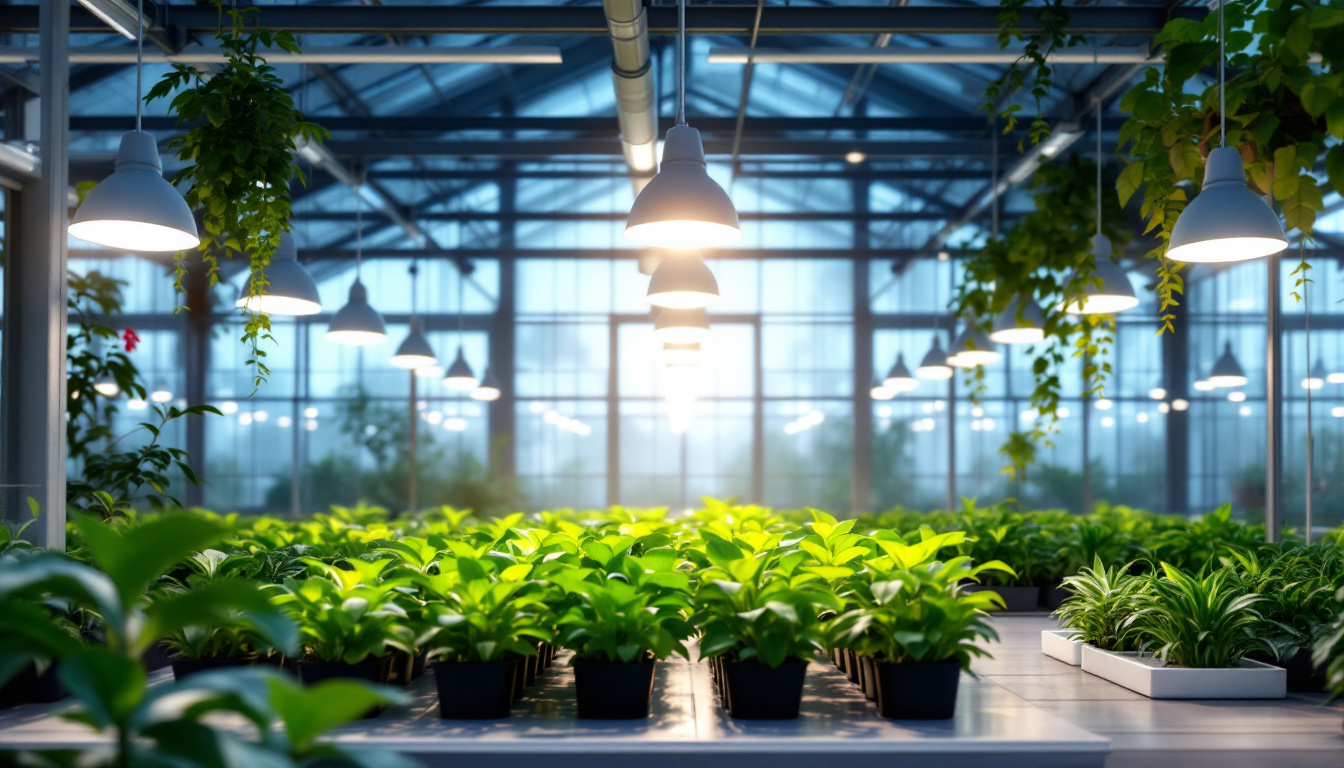
In the world of horticulture, greenhouse lighting plays a crucial role in enhancing plant growth, optimizing yields, and ensuring the overall health of crops. For lighting contractors, understanding the intricacies of greenhouse lighting can lead to improved project outcomes and satisfied clients. This article delves into the various aspects of greenhouse lighting, focusing on how contractors can boost efficiency and performance through effective lighting solutions.
Greenhouses are designed to create an optimal environment for plant growth, and lighting is a fundamental component of this ecosystem. Natural sunlight is often insufficient, especially during shorter days or in regions with less sunlight. Therefore, artificial lighting becomes essential for maintaining plant health and productivity.
Effective greenhouse lighting not only supports photosynthesis but also influences plant morphology, flowering, and fruiting. By providing the right spectrum and intensity of light, contractors can help growers achieve their desired outcomes, making it imperative to understand the specific needs of different plant species. Additionally, the timing and duration of light exposure can significantly affect growth cycles, making it crucial for growers to implement a lighting schedule that mimics natural conditions as closely as possible.
Moreover, advancements in lighting technology have led to the development of smart lighting systems that can be controlled remotely. These systems allow growers to adjust light intensity and duration based on real-time data, such as weather conditions and plant growth stages. This level of control not only enhances plant health but also optimizes energy use, resulting in cost savings for greenhouse operators.
Lighting contractors should be familiar with the various types of greenhouse lighting available. Each type has its unique advantages and applications:
Different plants require varying light spectra for optimal growth. Understanding the light spectrum is essential for lighting contractors to recommend the best solutions for their clients. The spectrum can be divided into:
Furthermore, the integration of both red and blue light in a balanced ratio can lead to enhanced photosynthetic efficiency, which is critical for maximizing growth rates. Understanding these nuances allows lighting contractors to tailor solutions that align with the specific goals of their clients, ensuring that each plant receives the optimal light conditions for its growth stage.
As energy costs continue to rise, the need for energy-efficient lighting solutions becomes paramount. Lighting contractors can significantly impact their clients’ operational costs by recommending energy-efficient systems that provide the necessary light without excessive energy consumption.
Implementing energy-efficient lighting not only reduces costs but also contributes to sustainability efforts. Many growers are now looking for ways to minimize their carbon footprint, and lighting contractors can play a pivotal role in this transition.
There are several strategies that lighting contractors can employ to enhance energy efficiency in greenhouse lighting:
When selecting a lighting system, contractors should consider several factors, including:
Proper installation of greenhouse lighting systems is critical to ensuring their effectiveness and longevity. Lighting contractors must adhere to best practices to provide clients with reliable and efficient solutions.
Before installation, a thorough assessment of the greenhouse layout is necessary. This includes determining the best locations for light fixtures to ensure even light distribution. Factors such as plant height, spacing, and growth stages should be considered to avoid shadowing and ensure that all plants receive adequate light.
Lighting systems require appropriate electrical setups to function safely and efficiently. Contractors should ensure that:
After installation, it is essential to test the lighting system to ensure it meets the required specifications. This includes checking light intensity, spectrum, and coverage. Adjustments may be necessary to optimize performance, and contractors should be prepared to make these changes based on the specific needs of the plants.
Regular maintenance of greenhouse lighting systems is vital for ensuring their longevity and efficiency. Lighting contractors should educate clients on the importance of routine checks and maintenance procedures.
Over time, dust and debris can accumulate on light fixtures, reducing their efficiency. Regular cleaning is essential to maintain optimal light output. Contractors can recommend specific cleaning schedules based on the greenhouse environment and the type of fixtures used.
Implementing monitoring systems can help track the performance of lighting systems over time. This includes checking for any flickering, dimming, or color shifts in the light output. Early detection of issues can prevent costly repairs and downtime.
As technology advances, older lighting systems may become less efficient. Contractors should stay informed about the latest developments in greenhouse lighting and advise clients on potential upgrades that could enhance performance and energy efficiency.
Examining successful greenhouse lighting projects can provide valuable insights for lighting contractors. These case studies highlight the importance of tailored lighting solutions and the impact they can have on plant growth and operational efficiency.
A large-scale vegetable producer faced challenges with inconsistent growth rates and low yields due to inadequate lighting. The contractor recommended a combination of LED and HID lights, strategically placed to maximize coverage. After installation, the grower reported a significant increase in yield and a reduction in energy costs.
A flower cultivation greenhouse struggled with flowering times and plant quality. The contractor implemented a full-spectrum LED lighting system that provided the necessary wavelengths for optimal flowering. The grower saw improved flower quality and a more uniform flowering schedule, resulting in higher sales and customer satisfaction.
As the horticultural industry continues to evolve, so too does the technology behind greenhouse lighting. Innovations in LED technology, smart controls, and energy-efficient solutions are paving the way for more efficient and sustainable practices.
Lighting contractors must stay abreast of these advancements to provide their clients with the best possible solutions. By embracing new technologies and approaches, contractors can enhance their service offerings and contribute to the success of their clients in the ever-competitive agricultural market.
Emerging technologies, such as dynamic lighting systems that adjust based on real-time plant needs, are on the horizon. These systems promise to revolutionize how greenhouse lighting is approached, allowing for unprecedented levels of efficiency and customization.
As sustainability becomes a focal point in agriculture, regulatory trends are likely to influence greenhouse lighting practices. Contractors should be prepared to adapt to new regulations that promote energy efficiency and environmental responsibility.
Greenhouse lighting is a critical component of successful horticultural practices, and lighting contractors play a vital role in optimizing these systems for their clients. By understanding the importance of light spectrum, energy efficiency, installation best practices, and maintenance, contractors can significantly enhance the performance of greenhouse lighting systems.
As the industry continues to evolve, staying informed about emerging technologies and regulatory trends will be essential for contractors looking to remain competitive. By embracing innovation and prioritizing efficiency, lighting contractors can not only boost their business but also contribute to the sustainability and success of the agricultural sector.
Ready to elevate your greenhouse lighting systems with the most efficient, high-quality solutions on the market? Look no further than LumenWholesale. Our commitment to empowering contractors with spec-grade lighting products at unbeatable wholesale prices ensures that your projects shine brighter while keeping costs down. With our extensive selection that meets the highest industry standards, you can confidently provide your clients with reliable, high-performance lighting. Plus, with free shipping on bulk orders, you can enjoy premium lighting at the best value — without hidden fees or compromises. Don’t miss out on the perfect blend of quality, affordability, and convenience. Visit LumenWholesale today and take the first step towards a brighter, more sustainable future in greenhouse lighting.

Discover the essential checklist for lighting contractors with “Light Bases.” This guide covers crucial steps and considerations to ensure flawless installations, enhance efficiency, and deliver exceptional lighting solutions for any project..

Discover the essential insights lighting contractors need about the 25 Watt Bulb Type G.

Discover why LED strip light covers are essential for lighting contractors.

Discover the advantages and drawbacks of solar lights for lighting contractors in this insightful article.